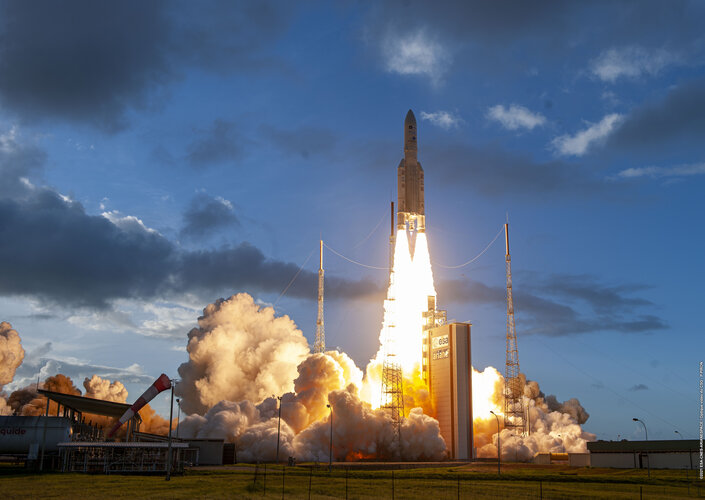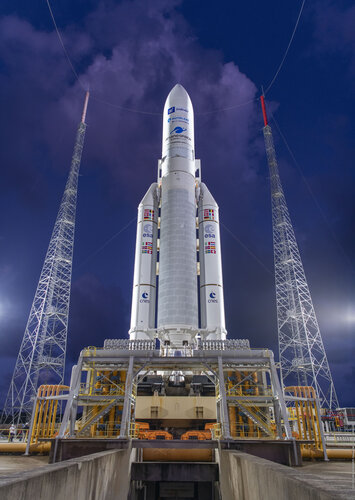
Copernical Team
High-stakes Boeing capsule launch postponed due to mishap at ISS
 Boeing and NASA postponed the launch the company's Starliner space capsule to the International Space Station on Friday after a mishap at the orbital laboratory on Thursday.
A United Launch Alliance Atlas V rocket had been scheduled to launch the capsule on an uncrewed test flight from Florida. But a new Russian module, Nauka, created a brief crisis at the space station when the module'
Boeing and NASA postponed the launch the company's Starliner space capsule to the International Space Station on Friday after a mishap at the orbital laboratory on Thursday.
A United Launch Alliance Atlas V rocket had been scheduled to launch the capsule on an uncrewed test flight from Florida. But a new Russian module, Nauka, created a brief crisis at the space station when the module' US watchdog upholds SpaceX's Moon lander contract
 NASA did not violate regulations when it decided to give SpaceX the sole contract to build a Moon lander, a watchdog said Friday, in a ruling that denied challenges by competitors Blue Origin and Dynetics.
The human landing system (HLS) contract, worth $2.9 billion, was given to Elon Musk's company in April, but was protested by the other bidders, who argued NASA was required to make multipl
NASA did not violate regulations when it decided to give SpaceX the sole contract to build a Moon lander, a watchdog said Friday, in a ruling that denied challenges by competitors Blue Origin and Dynetics.
The human landing system (HLS) contract, worth $2.9 billion, was given to Elon Musk's company in April, but was protested by the other bidders, who argued NASA was required to make multipl Government watchdog denies protests of SpaceX's lunar lander contract
 A U.S. government watchdog denied protests Friday of NASA's nearly $3 billion contract award to Elon Musk's SpaceX to build a lunar lander for astronaut missions.
In denying the arguments made by Jeff Bezos' Blue Origin and Alabama-based Dynetics, the Government Accountability Office noted that NASA's options for the contract were restricted by a lack of congressional funding.
NA
A U.S. government watchdog denied protests Friday of NASA's nearly $3 billion contract award to Elon Musk's SpaceX to build a lunar lander for astronaut missions.
In denying the arguments made by Jeff Bezos' Blue Origin and Alabama-based Dynetics, the Government Accountability Office noted that NASA's options for the contract were restricted by a lack of congressional funding.
NA World's first commercial re-programmable satellite blasts into space
 The world's first commercial fully re-programmable satellite lifted off from French Guiana on Friday on board an Ariane 5 rocket, ushering in a new era of more flexible communications.
Unlike conventional models that are designed and "hard-wired" on Earth and cannot be repurposed once in orbit, the Eutelsat Quantum allows users to tailor the communications to their needs - almost in real-ti
The world's first commercial fully re-programmable satellite lifted off from French Guiana on Friday on board an Ariane 5 rocket, ushering in a new era of more flexible communications.
Unlike conventional models that are designed and "hard-wired" on Earth and cannot be repurposed once in orbit, the Eutelsat Quantum allows users to tailor the communications to their needs - almost in real-ti Eutelsat Quantum liftoff
 Video:
00:00:49
Video:
00:00:49
The first flight of Ariane 5 in 2021 delivers two satellites including the ESA-backed telecommunications satellite Eutelsat Quantum into space.
Ariane 5 launches pioneering reprogrammable telecommunications satellite

Europe’s Ariane 5 has delivered two telecom satellites Star One D2 and Eutelsat Quantum into their planned transfer orbits.
Ariane 5 on the launch pad
 Image:
Ariane 5 is poised for liftoff on flight VA254 at Europe’s Spaceport in French Guiana
Image:
Ariane 5 is poised for liftoff on flight VA254 at Europe’s Spaceport in French Guiana Apollo 11 ascent stage may still be orbiting the moon

James Meador, an independent researcher at the California Institute of Technology, has found evidence that suggests the Apollo 11 ascent stage may still be orbiting the moon. He has written a paper outlining his research and findings and has posted it on the arXiv preprint server.
In 1969, NASA astronauts Neil Armstrong and Buzz Aldrin made history when they landed a craft successfully on the moon. After more than 21 hours on the surface, the astronauts blasted off the surface in a part of the Eagle lander called the ascent stage. They soon thereafter rendezvoused with Michael Collins in the command module which carried them back to Earth. Before departing for Earth, the ascent stage was jettisoned into space—NASA engineers assumed that it would crash back to the moon's surface sometime later. Meador reports that the ascent stage may not have crashed into the moon after all and might, in fact, still be orbiting the moon.
Meador began his investigation by considering whether it might be possible to find the ascent stage, which he assumed would be on the surface of the moon.
Russia blames space station lab incident on software failure

China's space propaganda blitz endures at slick new planetarium

China has opened the doors on what it bills as the world's largest planetarium, a slick new Shanghai facility showcasing the nation's recent extra-terrestrial exploits while notably downplaying those of space pioneers like the United States.
Beijing has spent much of this year bombarding the public with news of the country's rising space prowess, part of a larger propaganda blitz highlighting Chinese achievements under the ruling Communists to mark the party's 100th anniversary.
In recent months, China has landed a spacecraft on Mars, set loose a rover to explore it, and sent the first astronauts to a Chinese space station.
Scale-model replicas of spaceships from these and other missions figure prominently at the new Shanghai Planetarium, along with paeons to China's rapid scientific advancement, and clips of President Xi Jinping addressing the nation's taikonauts.
"This year we had several astronauts go to space, which is a source of pride for China," said a woman surnamed Zhou, who brought her young daughter.
